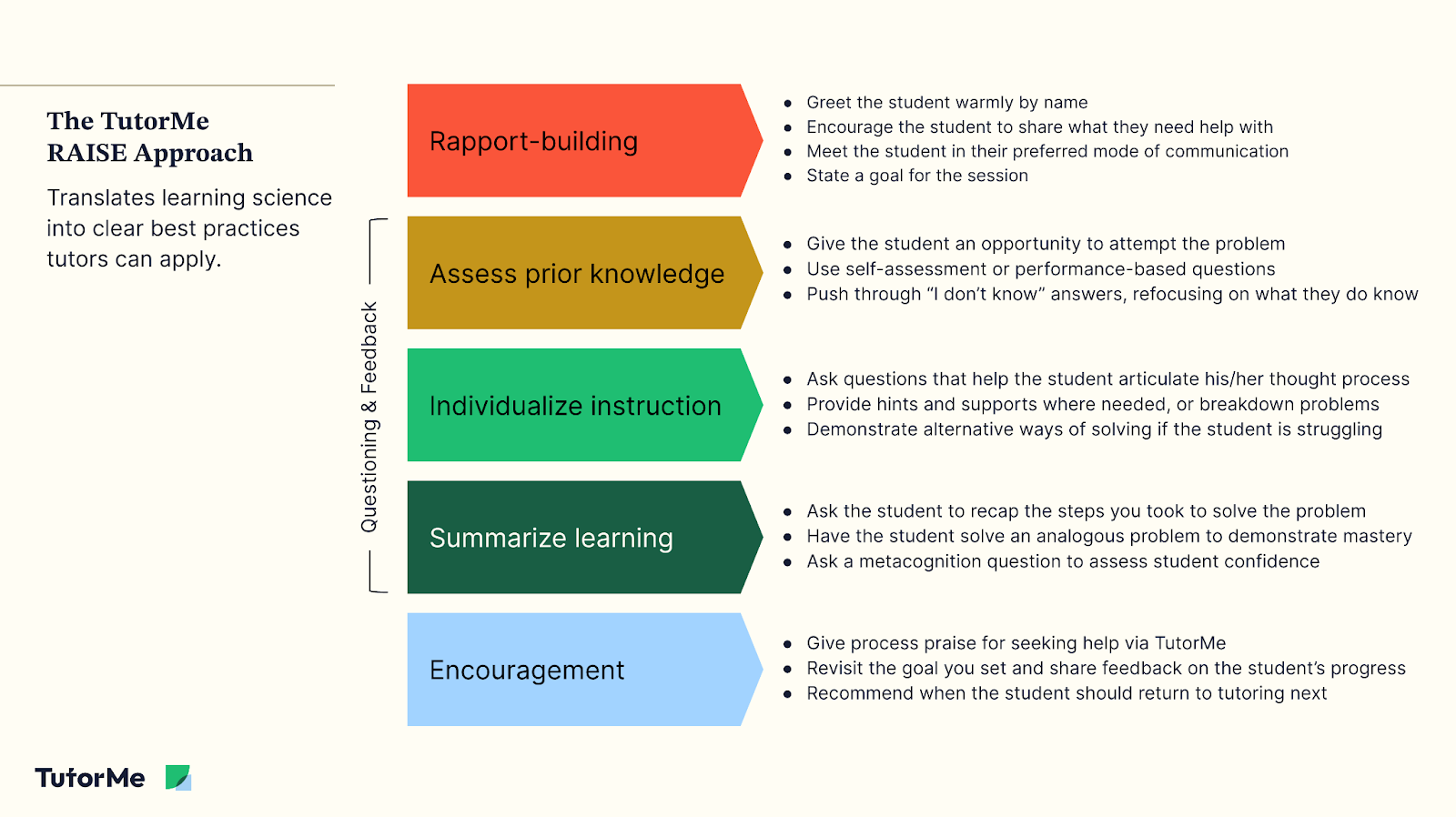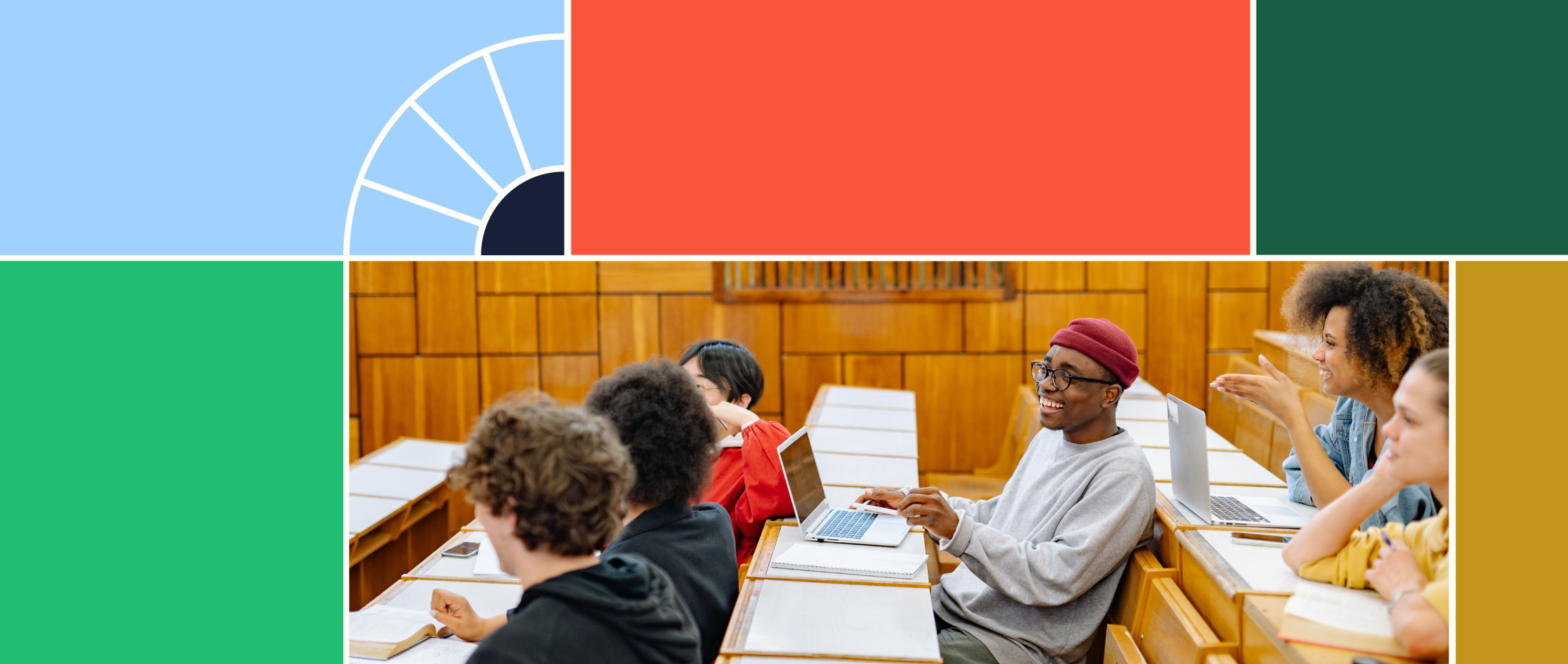The TutorMe RAISE Approach: Leading an effective and impactful tutoring session
The TutorMe RAISE approach translates the learning methodologies in the TutorMe logic model into a guiding framework for tutors on the TutorMe platform. The RAISE Approach is centered on two guiding principles to engage students: asking questions and providing feedback. It is centered on five easy-to-follow steps: rapport-building, assessment of prior knowledge, individualized instruction, structured practice, and encouragement.
At TutorMe, we believe that tutors are so much more than “just tutors”. You are cheerleaders. Mentors. Heroes. Change-makers. Trusted sidekicks.
Most of all, you are the one students can always turn to for that extra helping hand. And there is so much power and satisfaction in that role.
As a tutor, you have the opportunity to dramatically change a student’s learning journey. Your session may be the only time a student has the opportunity to work one-on-one with a subject expert, and that time is immensely precious – to you and your learners.
But tutoring is hard. It can be incredibly difficult to determine how to best support your student during your short time together. You know you can make a difference, but where do you start?
We know that a great tutoring session is rooted in learning science and utilizes best practices that are proven to help students learn. But diving into the research can be daunting – to say the least. We know how much you want to make a difference in every student’s life, so we’re here to help you make that difference.
To support your tutoring career, we’re introducing the TutorMe RAISE Approach.
This approach creates a recommended structure for tutoring sessions based on learning science. We’ll go into more details about this approach and what it means, but first, let’s take a step back and consider where this approach came from.
Using evidence to positively impact every student
The Education Team at GoGuardian dived deeply into the research on what makes an excellent tutoring session. Using this research, they created the TutorMe logic model. A logic model is a conceptual framework made to represent the expected outcomes of a program or product based on key components and how these components can logically impact desired outputs.
The TutorMe logic model outlines how TutorMe tutoring sessions can be designed to deliver impactful tutoring sessions for K-12 students. In other words, this logic model is a science-backed blueprint for the most effective tutoring session that can lead to the best learning outcomes for a student. Sounds cool? We agree. So, we took it a step further.
We took the logic model and put it into actionable steps so tutors can benefit from the research – without having to navigate all the jargon. We incorporated the learning methodologies in the logic model into the TutorMe RAISE Approach – to provide best practice guidance to the tutoring community.

Introducing the TutorMe RAISE Approach
The TutorMe RAISE Approach translates the learning methodologies in the TutorMe logic model into a guiding framework for tutors on the TutorMe platform to utilize when leading online tutoring sessions. This framework takes a student-centric approach to virtual support and sets up you and your student for success.
The RAISE Approach is centered on two guiding principles to engage your students:
- Asking Questions
- Providing Feedback
The best part? We broke it down into five, easy-to-follow steps!
Take a look at the figure below that covers the RAISE Approach. But don’t get nervous if you don’t understand some of the words – we’ll cover each step next with examples on how to use them in your next tutoring session.

Using the TutorMe RAISE Approach
As an online tutor, you can use the TutorMe RAISE Approach to facilitate effective tutoring sessions that help your learner master content and thrive on their education journey. This approach is simple to follow, based on best practices, and structured to fit within a normal tutoring period. Using the image above as a guide, let’s look at each step.
Step 1: Rapport-building: At the beginning of your session, it is important that you create an environment where your learner feels welcomed and you set a solid foundation of what the session needs to focus on.
How to do this: Start by greeting your learner warmly, and feel free to let your personality shine a bit. After all, there’s no reason why tutoring can’t be fun! Share a fun fact about yourself or ask the student to share something fun about themselves before you dive into learning – you never know what else you might have in common!
After, ask the student what they need help with. Using what they share, work collaboratively to set expectations and define a goal for the session. For example, you could say, “In this session, we will work on solving algebraic equations, and by the end of it, you'll be able to solve them independently.”
Step 2: Assessment of prior knowledge: As a tutor, you will need to understand what skill gaps and strengths a student may have before you can start supporting them. That way, your instruction is targeted, neither boring the student with instruction on topics they know well, nor frustrating them with questions that are simply too challenging.
How to do this: Assess the student’s prior knowledge by giving them an opportunity to attempt the problem or asking them to self-assess their knowledge on the topic. Use prior-knowledge assessment techniques such as, “What do you remember about how your teacher taught this?” or “How would you start solving this problem?” If a student responds with "I don't know," try refocusing their attention on what they do know. For example, when working with a math problem, you can state, “It’s okay that you don’t remember how to add fractions - can you tell me what you do know about fractions?”
If a student is working on a more broad topic, ask the student to explain what they understand about the topic, and then ask follow-up questions to gauge the depth of their understanding.
Step 3: Individualized instruction: This is the step where your skills as a tutor truly begin to shine and you work collaboratively with the student to master the skill or concept. The magic of 1:1 instruction lies in your ability to tailor questions and problems to the student’s unique level, and continuously adjust your approach as the student’s mastery moves throughout the session. Individualized instruction should take up the majority of the tutoring session.
How to do this: As you work collaboratively with your student to solve the problem or complete an assignment, use autonomy-supportive language and guiding questions to help the student articulate their thought process. For example, guide a student by asking “What would you try to do next?”, “Why did you take that step?”, or “What’s a different way you could have approached this problem?”
If your student gets stuck, provide supportive hints or break down the problem into smaller steps. For example, if a student is working on a reading assignment, create a list or graphic organizer together to help them organize their thoughts. If they’re working on a math problem, help them break the problem into step-by-step chunks or leverage visuals to help make abstract problems more tangible.
Be sure to utilize the numerous learning tools available to you on the TutorMe platform. For example, you can draw out problems on the Lesson Space’s whiteboard, have your student screenshare with you, or have your student upload an image of their work. As a good practice tip, you can use the opt-in live video option in the Lesson Space, so you can give face-to-face instruction and there’s no confusion.
Step 4: Summarize learning: As the session nears the end, work collaboratively with your student to summarize their learning. This will help your student remember everything you covered, so they can utilize it later on future assignments or in class. One of the most robust findings from 100+ years of cognitive science research is that a significant amount of learning occurs when students pull information “out” through retrieval practice, not when they get information “in” through reading or lectures.
How to do this: Summarization can occur in a variety of structures, such as recapping the steps taken in solving the problem or having the student work on a similar problem to demonstrate mastery. Be sure to ask metacognitive questions, such as, “How confident are you in solving similar problems?” or “What’s something you’d like to become more confident in?”
These questions help a student conceptualize where they are on a metacognitive level. You can also have the student explain in their own words what they learned during the session and how they can apply it.
Step 5: Encouragement: We all love to end a task feeling satisfied and rewarded in what we accomplished. This is no different for the students you work with! At the end of the session, congratulate the student on their progress and provide any recommendations needed for follow-up sessions. Follow-up sessions are a great opportunity to reinforce their learning and build upon the relationship you have established in this session.
How to do this: Try not to just congratulate your student on a job well done, but pick out specific processes to highlight. For example, you can highlight how well your student did on breaking down a problem or congratulate them on identifying that they needed help in the first place.
Leading a successful tutoring session
Now that we’ve covered the five-steps of the TutorMe RAISE Approach, you have the tools you need to lead a successful tutoring session. Remember, the RAISE Approach is a framework to guide you and your student through the learning process using evidence-based learning methodologies. By using this approach, you’re setting the foundation for an impactful tutoring session that allows for your student to not only learn the content at hand, but gain strategies that will help them grow into independent learners.
But this approach is not complete without YOU. As a tutor, you bring your unique perspective and personality into every session, and create the human connection that sets us apart. So, let that lovely personality shine as you help students everyday learn and thrive!
Are you interested in tutoring with TutorMe? Check out our requirements and apply today!










